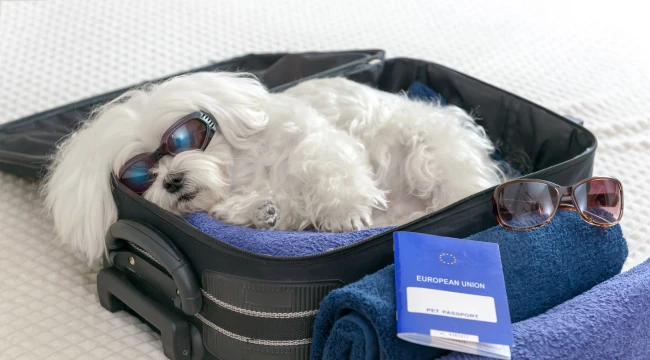
Traveling with pets is more than a trend; it’s a joyful experience that many pet owners cherish.
As families increasingly consider their furry friends as vital members, the need for detailed planning and consideration for pet travel has become essential.
Whether it’s a weekend getaway or a long vacation, taking a pet along requires careful thought and organization.
From choosing the right transportation to finding pet-friendly hotels with kitchens, this article covers it all.
1. Understanding Pet Travel Regulations
Understanding regulations for pet travel is the first step towards a smooth journey.
Every country has specific rules, and sometimes even different states or regions within a country can vary in their requirements.
For instance, some European countries may require a pet passport, while others only ask for a health certificate.
Vaccination records, microchip information, and any necessary permits must be at hand.
Keeping a folder with all these documents readily accessible can help ensure a smooth travel experience, especially during international trips.
2. Choosing the Right Mode of Transportation
The journey can be as exciting as the destination itself, especially if the pet’s comfort is taken into account.
Not all airlines are equal in their pet policies; some may allow small pets in the cabin, while others may have special facilities in the cargo hold.
On a road trip, frequent stops for stretch breaks, and using a pet restraint system can make the journey enjoyable for everyone.
Local trains and buses might have specific rules regarding pets. Knowing them in advance can prevent unpleasant surprises.
Selecting the right mode of transportation is not just about comfort; it’s about the overall well-being and happiness of the pet.
Each mode of travel offers its unique advantages and challenges, and understanding them can lead to a delightful travel experience.
Air Travel: If flying is the choice, careful consideration must be given to the airline’s specific policies. Some offer cabins specially designed for pets, turning a potentially stressful experience into a pleasant one.
Car Travel: For those who prefer the freedom of the open road, planning rest stops that include pet-friendly parks can turn the journey into an adventure. Special pet seat belts and carriers can ensure safety while allowing the pet to enjoy the view.

Trains and Buses: These can be convenient options for shorter distances, especially in regions where such services accommodate pets. Researching and booking in advance is vital.
Moreover, the personality of the pet can significantly influence the decision. Some pets might enjoy a leisurely drive with the windows down, while others may prefer the quick efficiency of air travel.
Travel Accessories: Investing in quality travel accessories can add to the comfort and safety of the journey. Options might include:
- A well-ventilated carrier for air travel
- A comfortable and secure harness for car trips
- Portable water and food dishes for on-the-go nourishment
Creativity and thoughtfulness in choosing the mode of transportation can turn the travel itself into an exciting part of the vacation, building memories and strengthening the bond between pet and owner.
Whether by air, road, or rail, considering the pet’s needs and personality ensures a journey filled with joy and love.
3. Selecting Pet-Friendly Accommodations
Accommodations can make or break a vacation, especially when traveling with pets. From budget hotels to luxurious resorts, many now offer special amenities for pets.
Searching for pet-friendly hotels with kitchens can provide the added benefit of preparing a pet’s favorite meal right in the room.
Some campgrounds welcome pets and even provide special facilities for them.
Remember to read reviews and possibly even call ahead to confirm the pet policy; what’s promised online might differ in reality.
4. Packing Essentials for Your Pet
Packing for a pet is much like packing for a child. Essentials vary based on the destination and the mode of transportation.
Bringing familiar food and potable water dishes can help maintain a regular diet. Including basic medications, band-aids, and a small guidebook on pet first aid is wise.
A favorite toy or blanket can ease travel anxiety, and a handy checklist can ensure nothing vital is left behind.
5. Health and Safety Considerations
Health and safety are paramount when traveling with pets. Ensuring all vaccinations are up to date and carrying necessary medications is crucial.
Besides a collar tag, microchipping adds an extra layer of security if a pet gets lost.
Consulting with a veterinarian before travel can provide peace of mind and specific health-related advice.
6. Planning Activities and Excursions
Planning activities that include pets can enhance the vacation experience.
Beaches, parks, and trails often welcome pets, but understanding specific rules is key.
In some cities, leash laws are stringent; knowing them in advance can prevent potential problems.
Including pets in activities ensures they are not left behind and can enjoy the vacation as much as their human counterparts.
7. Coping with Emergencies
Emergencies are unpredictable, and having a strategy is essential. Having local veterinary numbers can be a lifesaver.
Planning for unexpected situations like illness can include researching nearby veterinary clinics or pet-friendly emergency shelters.
Preparation is key; a small effort in planning can save a stressful situation later.
Emergencies are unpredictable, and having a strategy is essential. Having local veterinary numbers can be a lifesaver.
Planning for unexpected situations like illness can include researching nearby veterinary clinics or pet-friendly emergency shelters. Preparation is key; a small effort in planning can save a stressful situation later.
Moreover, it’s prudent to be aware of common pet ailments that might occur during travel, such as motion sickness or anxiety.
A travel emergency kit tailored to your pet’s needs can be a vital part of your luggage.
Discussing potential travel-related health issues with your veterinarian before you leave and carrying prescribed medications as needed ensures you’re prepared for any sudden health concerns.
Here are some essential items for a pet travel emergency kit:
- First Aid Supplies: Gauze, bandages, adhesive tape, scissors
- Medication: Any prescribed medicines, flea and tick prevention
- Comfort Items: Extra leash, favorite toy, blanket
- Hygiene Essentials: Waste bags, grooming wipes
Understanding and preparing for potential emergencies with your pet is not just about dealing with the unexpected; it’s about ensuring the wellbeing and comfort of your furry friend no matter what may come your way. In the world of pet travel, a stitch in time truly saves nine.
Conclusion
Traveling with pets is a delightful experience filled with unique memories.
By following this guide, pet owners can ensure that each step of the journey, from planning to the return home, is filled with joy and free from unnecessary stress.
The rise in pet-friendly amenities, from airlines to budget hotels, reflects a growing understanding of the importance of pets in our lives.
So pack those bags, gather the necessary documents, and embark on a wonderful adventure with a beloved pet.
Happy travels!



